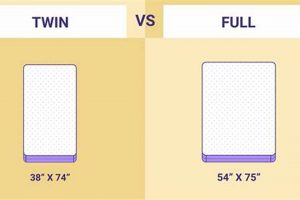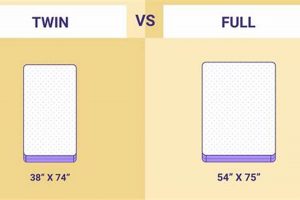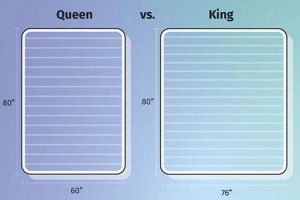The comparison centers on two distinct mattress thickness categories, measured vertically from the top to the bottom surface. One measures ten inches in depth, while the other extends to twelve inches. The difference in height directly impacts factors such as support, comfort, and suitability for various sleep positions and body types.
Increased mattress thickness often correlates with enhanced support and durability. A thicker profile may accommodate more substantial support cores and comfort layers, potentially extending the product’s lifespan and providing improved spinal alignment. The choice between these dimensions depends significantly on individual preferences, budgetary considerations, and specific sleep needs.
The following sections will delve into specific aspects influenced by differing mattress thicknesses, including material composition, support system design, suitability for diverse sleeping styles, and associated cost implications.
Considerations for Selecting Mattress Thickness
Choosing between mattress thicknesses requires careful evaluation of individual needs and preferences. Several factors contribute to determining the optimal depth for a specific user.
Tip 1: Assess Body Weight and Sleep Position: Individuals with higher body weight may benefit from the increased support offered by a thicker mattress. Similarly, side sleepers may find that a deeper mattress allows for greater contouring around the shoulders and hips, promoting spinal alignment.
Tip 2: Evaluate Support Core Density: The composition and density of the support core, whether it’s made of coils, foam, or latex, significantly impact the overall feel and longevity of the mattress. A thicker mattress may accommodate a more robust and durable support core.
Tip 3: Consider Layer Composition: The number and type of comfort layers play a crucial role in determining pressure relief and temperature regulation. A thicker mattress allows for more extensive comfort layering, potentially enhancing sleep quality.
Tip 4: Examine Edge Support Construction: Edge support is particularly important for individuals who sleep near the edge of the bed or require assistance getting in and out of bed. Thicker mattresses often incorporate enhanced edge support systems.
Tip 5: Account for Bed Frame Height: The overall height of the bed frame, mattress, and bedding should be considered to ensure comfortable entry and exit from the bed. A thicker mattress may necessitate a lower-profile bed frame.
Tip 6: Review Warranty and Trial Periods: Manufacturers often offer warranties and trial periods that allow consumers to test the mattress at home and assess its suitability before making a final purchasing decision. Review these terms carefully before committing to a purchase.
Tip 7: Research Material Certifications: Certifications such as CertiPUR-US or OEKO-TEX ensure that the mattress materials meet specific safety and environmental standards. Prioritize mattresses that have been independently tested and certified.
Careful consideration of these elements will assist in selecting a mattress that adequately addresses individual sleep requirements, providing optimum comfort and support.
The subsequent sections will explore specific mattress types and their corresponding suitability for various sleep preferences.
1. Support layer depth
Support layer depth is a critical factor when comparing mattress thicknesses, specifically influencing the suitability of a 10-inch versus a 12-inch mattress for diverse individuals and sleep preferences. The depth of this layer directly impacts the mattress’s ability to provide adequate spinal alignment and overall support.
- Spinal Alignment and Posture Correction
A deeper support layer, often found in 12-inch mattresses, is generally more effective at maintaining proper spinal alignment, particularly for individuals with higher body weights or those who sleep on their backs or stomachs. The added depth allows for more robust construction and resistance to compression, preventing sagging and promoting a neutral spinal posture. A 10-inch mattress might suffice for lighter individuals, but may lack the necessary support for heavier sleepers, potentially leading to discomfort or back pain.
- Material Composition and Density
The type and density of materials used in the support layer contribute significantly to its performance. High-density foam, pocketed coils, or latex are commonly used. A 12-inch mattress often accommodates a more substantial layer of these materials, providing greater long-term durability and resistance to deformation. In contrast, a 10-inch mattress may utilize thinner, less dense materials to reduce cost, which can compromise its overall support and lifespan.
- Weight Distribution and Pressure Relief
An adequately deep support layer facilitates even weight distribution, reducing pressure points that can cause discomfort and disrupt sleep. The enhanced depth found in a 12-inch mattress allows for better contouring to the body’s curves, minimizing pressure on areas like the hips and shoulders. A 10-inch mattress may not offer the same level of targeted pressure relief, potentially leading to restless sleep, especially for side sleepers.
- Motion Isolation and Stability
A thicker support layer contributes to improved motion isolation, preventing disturbances caused by movement from transferring across the mattress. This is particularly beneficial for couples. The greater mass and density in a 12-inch mattress tend to absorb and dampen motion more effectively than a 10-inch mattress, leading to a more peaceful sleep environment. This aspect is less pronounced in all-foam mattresses but more relevant in hybrid or innerspring designs.
Therefore, the depth of the support layer directly influences the overall performance and suitability of a mattress. Selecting between a 10-inch and 12-inch model requires careful consideration of individual weight, sleep position, and material preferences to ensure optimal comfort and spinal support. A 12-inch mattress with a robust support layer is often a preferred choice for those seeking long-term durability and enhanced orthopedic benefits.
2. Comfort layer volume
The volume of the comfort layer significantly influences the feel and performance characteristics of a mattress. When evaluating a 10-inch versus a 12-inch mattress, understanding how this volume varies and its subsequent effects is crucial.
- Pressure Relief and Contouring
A larger comfort layer volume, generally found in 12-inch mattresses, allows for greater conformity to the body’s contours. This results in enhanced pressure relief, particularly at sensitive areas like the shoulders and hips. For side sleepers, a thicker comfort layer can prevent pressure buildup that leads to discomfort and restless sleep. Conversely, a 10-inch mattress, with a smaller comfort layer volume, may provide less effective pressure relief, potentially causing aches and pains during the night.
- Material Composition and Density
The types of materials used within the comfort layer, such as memory foam, latex, or polyfoam, influence its overall performance. A 12-inch mattress often incorporates a more substantial or diverse layering of these materials, allowing for a customized feel that balances support and cushioning. For example, a 12-inch mattress might feature a thicker layer of high-density memory foam for enhanced pressure relief and motion isolation. A 10-inch model may utilize a thinner layer of less dense foam, potentially compromising comfort and durability.
- Temperature Regulation
The volume and composition of the comfort layer can affect the mattress’s ability to regulate temperature. A thicker comfort layer, especially when constructed with materials like open-cell foam or gel-infused memory foam, can promote airflow and dissipate heat more effectively. This is crucial for individuals who tend to sleep hot. A 10-inch mattress, with its smaller comfort layer volume, may retain more heat, leading to discomfort and sleep disruptions.
- Long-Term Durability and Performance
A larger comfort layer volume typically translates to greater long-term durability. Thicker layers of high-quality materials are less prone to compression and degradation over time. This ensures that the mattress maintains its comfort and support characteristics for a longer period. A 10-inch mattress, with a thinner comfort layer, may exhibit faster wear and tear, requiring replacement sooner than a 12-inch model.
In summary, the comfort layer volume is a significant differentiator between 10-inch and 12-inch mattresses. The increased volume in 12-inch models often results in superior pressure relief, temperature regulation, and long-term durability, making them a potentially better choice for individuals seeking enhanced comfort and support. However, individual preferences and budgetary considerations should also be factored into the decision-making process.
3. Overall profile height
Overall profile height, as it relates to mattress selection, directly corresponds to the vertical distance from the bottom to the top surface of the mattress. In the context of a “10 vs 12 inch mattress” comparison, this dimension influences several key factors that affect user experience.
- Accessibility and Bed Height
The overall profile height impacts ease of ingress and egress from the bed. A significantly taller mattress, such as a 12-inch model combined with a high bed frame, might pose challenges for individuals with mobility issues or shorter stature. Conversely, a lower profile, as found in some 10-inch mattresses, may be more suitable for those requiring a lower sleeping surface. The combination of mattress height and bed frame height should be considered to ensure comfortable and safe access.
- Aesthetics and Bedroom Dcor
The mattress profile contributes to the overall aesthetic of the bedroom. A taller mattress can create a more substantial and luxurious appearance, while a thinner mattress may present a more minimalist or modern look. The selected profile should complement the existing bedroom dcor and bed frame style. For example, a platform bed typically pairs well with a thinner mattress, whereas a more ornate bed frame may be better suited to a thicker profile.
- Sheet Fit and Compatibility
Mattress profile height dictates the required depth of fitted sheets. Standard fitted sheets are typically designed to accommodate mattresses up to a certain thickness. Using sheets that are too small for a taller mattress, such as a 12-inch model, can result in the sheets popping off or being difficult to secure. Conversely, using excessively deep sheets on a thinner mattress, like a 10-inch model, can lead to a loose and ill-fitting appearance. Proper sheet selection ensures a secure and comfortable fit.
- Weight Distribution and Support
While not solely determined by overall profile height, the thickness of the mattress can influence its weight distribution and support capabilities. A thicker mattress may accommodate more substantial support cores and comfort layers, potentially providing improved spinal alignment and pressure relief. However, it’s essential to consider the materials and construction methods used within the mattress, as these also play a critical role in determining overall support and comfort.
Therefore, the overall profile height is a key consideration when choosing between a 10-inch and 12-inch mattress. Its impact on accessibility, aesthetics, sheet fit, and potential influence on support capabilities should be carefully evaluated to ensure the selected mattress meets individual needs and preferences. The ideal profile height balances comfort, functionality, and aesthetic considerations within the bedroom environment.
4. Edge support strength
Edge support strength refers to the structural integrity of a mattress’s perimeter, crucial for preventing collapse or sagging when weight is applied near the edges. In the context of a 10-inch versus 12-inch mattress, this feature directly impacts usable surface area, ease of entry and exit, and overall durability.
- Foam Encasement and Perimeter Coils
Many mattresses utilize foam encasement or reinforced perimeter coils to enhance edge support. These structures provide a firm boundary that resists compression. A 12-inch mattress often has more room for robust encasement, potentially leading to superior edge support compared to a 10-inch model. For instance, a 12-inch mattress may incorporate thicker, higher-density foam rails around the perimeter, offering greater stability.
- Usable Sleep Surface
Strong edge support maximizes the usable sleep surface of the mattress. Without adequate edge support, the perimeter of the mattress becomes unstable, discouraging sleepers from utilizing the full width. A 12-inch mattress with enhanced edge support allows individuals to sleep closer to the edge without feeling like they might roll off, increasing comfort and usable space, particularly for couples sharing a bed.
- Ease of Entry and Exit
Firm edges facilitate easier entry and exit from the bed. Individuals, especially those with mobility limitations, rely on the edge of the mattress for support when sitting or standing. A 10-inch mattress with weak edge support may compress significantly under weight, making it difficult to push off or maintain balance. A 12-inch mattress with reinforced edges offers a more stable and supportive surface for these activities.
- Long-Term Durability
Robust edge support contributes to the long-term durability of the mattress. Constant compression and deformation of the edges can lead to premature sagging and breakdown of the mattress structure. A 12-inch mattress, equipped with durable edge reinforcements, is likely to maintain its shape and support characteristics longer than a 10-inch model with weaker edges, particularly under consistent use.
Therefore, edge support strength is a significant differentiator between 10-inch and 12-inch mattresses, influencing usable surface area, ease of mobility, and overall product lifespan. The greater potential for enhanced edge support in a 12-inch mattress can represent a significant benefit for individuals seeking a stable and durable sleep surface.
5. Motion transfer reduction
Motion transfer reduction, the minimization of movement felt on one area of a mattress when another area is disturbed, is a significant factor influencing sleep quality, particularly for co-sleepers. The thickness of a mattress, as in a “10 vs 12 inch mattress” comparison, can directly impact this characteristic. A thicker mattress, such as the 12-inch model, often incorporates more substantial layers of motion-isolating materials like memory foam or individually encased coils. These components work to absorb movement at its source, preventing it from propagating across the mattress surface. The cause-and-effect relationship is clear: increased mattress thickness, combined with specific material choices, reduces motion transfer.
The importance of motion transfer reduction as a component of a 10-inch versus 12-inch mattress lies in its ability to minimize sleep disruptions caused by a partner’s tossing and turning. For example, consider a couple where one partner is a restless sleeper. With a 10-inch mattress lacking adequate motion isolation, the other partner may experience frequent awakenings due to transmitted movement. Conversely, a 12-inch mattress with superior motion transfer reduction would significantly mitigate these disturbances, promoting more restful sleep for both individuals. Practical applications extend beyond couples; individuals sharing a bed with pets or children can also benefit from improved motion isolation.
Understanding the relationship between mattress thickness and motion transfer is essential for informed consumer decision-making. While a 12-inch mattress may offer enhanced motion isolation due to its increased material volume, the specific materials and construction methods employed are equally important. Mattresses utilizing interconnected coils, regardless of thickness, tend to exhibit higher motion transfer. Therefore, consumers should prioritize mattresses with motion-isolating features, such as memory foam or individually pocketed coils, when selecting between a 10-inch and 12-inch model. The choice ultimately depends on individual needs and preferences, but the understanding of motion transfer reduction provides a critical framework for evaluating mattress suitability.
6. Pressure relief effectiveness
Pressure relief effectiveness is a critical attribute of mattresses, directly influencing sleep quality and comfort. It defines the mattress’s capacity to minimize pressure points, particularly in areas like the shoulders, hips, and spine. The consideration of pressure relief is intrinsically linked to mattress thickness, making the “10 vs 12 inch mattress” comparison highly relevant.
- Conformability and Material Depth
A mattress’s conformability, its ability to mold to the body’s shape, directly affects pressure relief. Greater material depth, typically found in 12-inch mattresses, often allows for more extensive conformability. This is because thicker mattresses can incorporate multiple layers of varying densities, providing both support and cushioning. A 10-inch mattress, with less material depth, may offer less effective contouring, potentially leading to increased pressure points. The specific materials used, such as memory foam or latex, further influence conformability.
- Layer Composition and Density Distribution
Pressure relief is optimized by strategic layer composition and density distribution within the mattress. A 12-inch mattress can accommodate a more complex layering system, with softer top layers for initial comfort and firmer support layers to prevent bottoming out. This gradient approach is more challenging to achieve in a 10-inch mattress due to space constraints. The distribution of material densities is crucial; higher-density materials provide support, while lower-density materials offer cushioning and pressure relief.
- Spinal Alignment and Support
Effective pressure relief contributes to proper spinal alignment, which is essential for long-term comfort and health. A mattress that conforms well to the body’s curves, like a 12-inch model with targeted pressure relief zones, can help maintain a neutral spinal position. This reduces strain on the back and neck muscles. A 10-inch mattress may lack the necessary support and contouring to promote optimal spinal alignment, potentially exacerbating existing back pain or discomfort.
- Individual Sleeping Position
The effectiveness of pressure relief is highly dependent on an individual’s sleeping position. Side sleepers, for example, require greater pressure relief in the shoulder and hip areas to prevent discomfort. A 12-inch mattress with a thick comfort layer is often better suited for side sleepers than a 10-inch model. Back sleepers benefit from a balance of support and pressure relief, which can be achieved in both 10-inch and 12-inch mattresses, depending on the specific construction. Stomach sleepers generally require firmer support to prevent excessive sinking, making material composition a more critical factor than overall thickness.
In summary, pressure relief effectiveness is closely tied to mattress thickness, although material composition and construction also play significant roles. While a 12-inch mattress often offers greater potential for enhanced pressure relief due to increased material depth and layering capabilities, the ideal choice depends on individual sleeping preferences, body weight, and specific support needs. Careful consideration of these factors is essential when selecting between a 10-inch and 12-inch mattress to optimize sleep quality and comfort.
7. Bed frame compatibility
Bed frame compatibility represents a critical consideration when selecting a mattress, directly impacting both functionality and aesthetics. The interaction between mattress thickness and bed frame design influences support, stability, and the overall user experience. The choice between a 10-inch versus 12-inch mattress necessitates careful assessment of bed frame specifications.
- Platform Bed Considerations
Platform beds, characterized by their solid or slatted surfaces, often dictate specific mattress height requirements. A thicker 12-inch mattress might obscure the headboard, diminishing the bed’s aesthetic appeal. Conversely, a 10-inch mattress might appear too low, creating a visual imbalance. Careful measurement and consideration of desired aesthetic are essential for optimal compatibility.
- Slatted Bed Frame Support
Slatted bed frames require sufficient mattress thickness to prevent sagging between the slats. A 10-inch mattress may not provide adequate support if the slats are spaced too far apart, potentially compromising spinal alignment and mattress longevity. A 12-inch mattress generally offers greater rigidity and weight distribution, minimizing the risk of sagging. The spacing and width of the slats are critical factors in determining compatibility.
- Headboard Height and Visibility
Headboard height significantly influences the perceived visual balance of the bed. A thick mattress, such as a 12-inch model, can obscure a low-profile headboard, negating its design features. Conversely, a 10-inch mattress might leave an excessive gap, creating an awkward aesthetic. Measuring the headboard height and calculating the exposed portion with the chosen mattress is crucial for achieving a harmonious visual effect.
- Enclosed Bed Frames and Depth Requirements
Enclosed bed frames, featuring side rails that partially conceal the mattress, impose specific depth limitations. A 12-inch mattress may exceed the frame’s depth capacity, resulting in an exposed edge that compromises the bed’s design. A 10-inch mattress is often a more suitable choice for enclosed frames, ensuring a flush fit and maintaining the intended aesthetic. Verifying the internal dimensions of the bed frame is essential for ensuring compatibility.
The relationship between mattress thickness and bed frame design is paramount for achieving optimal functionality and aesthetics. Selecting between a 10-inch and 12-inch mattress requires careful consideration of bed frame specifications, including platform height, slat spacing, headboard visibility, and enclosure depth. Proper assessment ensures compatibility, promotes longevity, and enhances the overall sleep environment. Additional considerations, such as under-bed storage clearance, may further influence the ideal mattress thickness.
Frequently Asked Questions
This section addresses common inquiries regarding the selection of mattresses based on thickness, specifically focusing on the distinction between 10-inch and 12-inch models.
Question 1: Is a thicker mattress invariably superior to a thinner mattress?
No. Thickness is but one determinant of mattress quality. Material composition, construction methods, and individual sleep preferences also significantly influence overall performance and suitability.
Question 2: Does a 12-inch mattress necessarily provide more support than a 10-inch mattress?
Not necessarily. Support is primarily governed by the core construction of the mattress, including the type and density of materials used in the support layer. A well-constructed 10-inch mattress can offer comparable or even superior support to a poorly designed 12-inch model.
Question 3: How does mattress thickness affect temperature regulation?
Thickness can indirectly influence temperature regulation. A thicker mattress allows for more substantial comfort layers, which may incorporate materials designed to promote airflow and dissipate heat. However, the specific materials used, such as open-cell foam or gel-infused memory foam, are the primary drivers of temperature regulation.
Question 4: Does a thicker mattress always require deeper pocket sheets?
Yes. Fitted sheets must be adequately deep to securely cover the mattress. A 12-inch mattress necessitates deeper pocket sheets than a 10-inch model to prevent slippage and ensure a proper fit.
Question 5: How does mattress thickness impact the ease of getting in and out of bed?
Overall bed height, determined by the combined height of the bed frame and mattress, affects accessibility. A significantly thicker mattress may make it challenging to enter or exit the bed, particularly for individuals with mobility issues. The selection of mattress thickness should consider the bed frame height and individual needs.
Question 6: Is a 12-inch mattress always more expensive than a 10-inch mattress?
Generally, a thicker mattress requires more materials and labor, potentially resulting in a higher price point. However, pricing is also influenced by brand reputation, material quality, and construction complexity. It is possible to find 10-inch mattresses that are more expensive than certain 12-inch models.
Mattress thickness is a crucial factor to consider, but it should not be the sole determinant in the selection process. Evaluating material composition, support system design, and individual preferences is essential for making an informed decision.
The subsequent section will summarize the key considerations and provide final recommendations for selecting the appropriate mattress thickness.
Concluding Remarks on Mattress Thickness
This exploration of the “10 vs 12 inch mattress” choice reveals nuanced considerations beyond mere dimension. The investigation encompassed support, comfort, accessibility, and compatibility factors directly influenced by mattress thickness. While a 12-inch mattress offers potential advantages in material volume and layering, a 10-inch mattress can provide adequate support and comfort when constructed with quality materials and appropriate design. Individual needs and bed frame specifications remain paramount determinants.
The decision between these mattress thicknesses requires careful evaluation of personal requirements and constraints. Informed selection, guided by an understanding of the aforementioned factors, is crucial for optimizing sleep quality and ensuring long-term satisfaction. Further research into specific mattress types and material properties is recommended to complement the insights presented here, ultimately facilitating a well-informed purchasing decision.


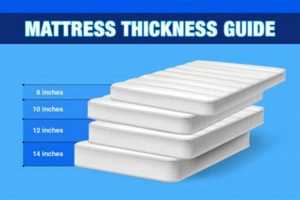
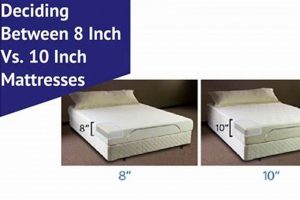
![Mattress Pad vs Topper: Find the Best Sleep [Guide] Organic & Natural Mattress Buyer’s Guide: Non-Toxic Sleep Solutions Mattress Pad vs Topper: Find the Best Sleep [Guide] | Organic & Natural Mattress Buyer’s Guide: Non-Toxic Sleep Solutions](https://mattressworldpa.com/wp-content/uploads/2025/07/th-1024-300x200.jpg)
